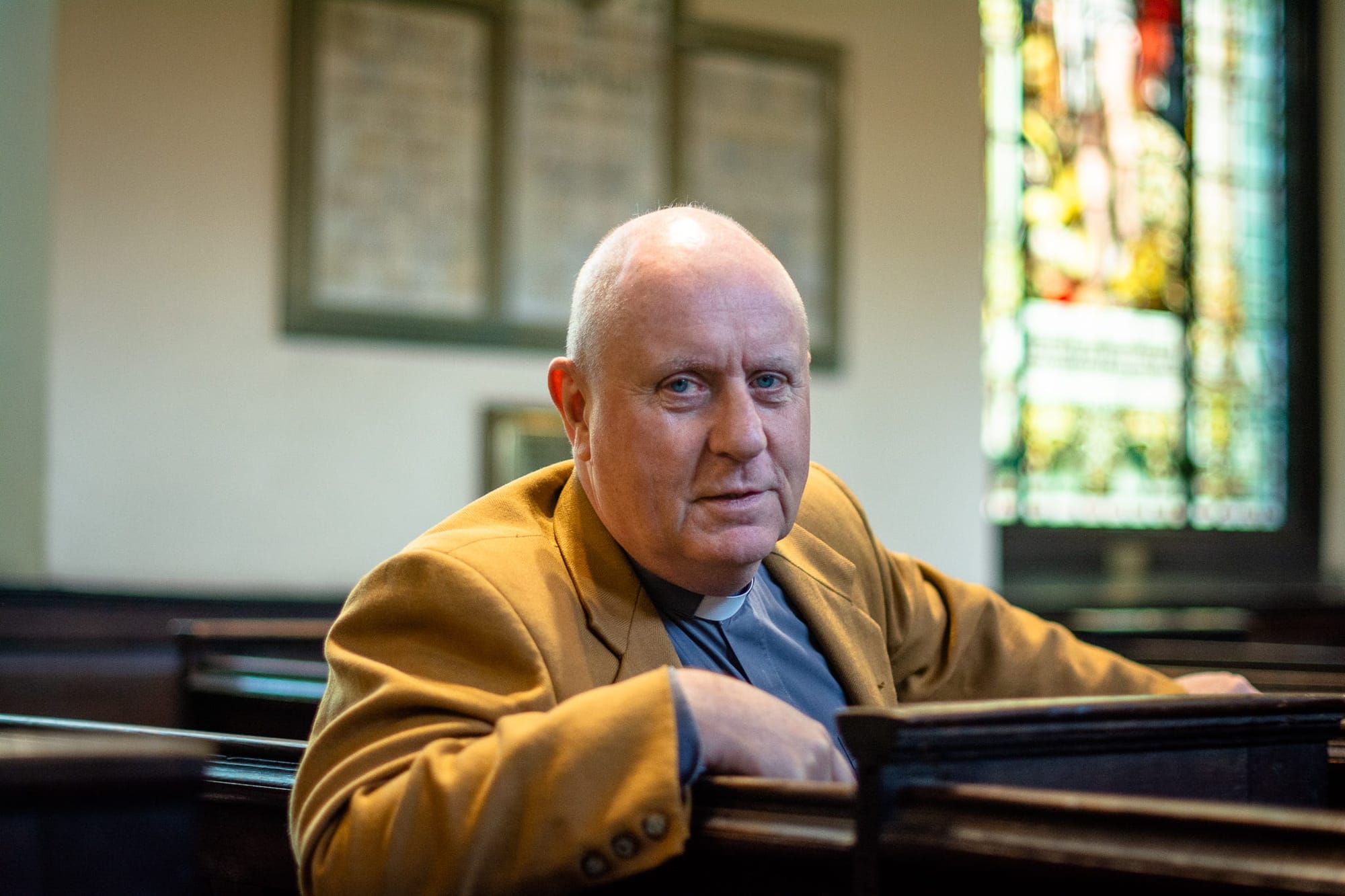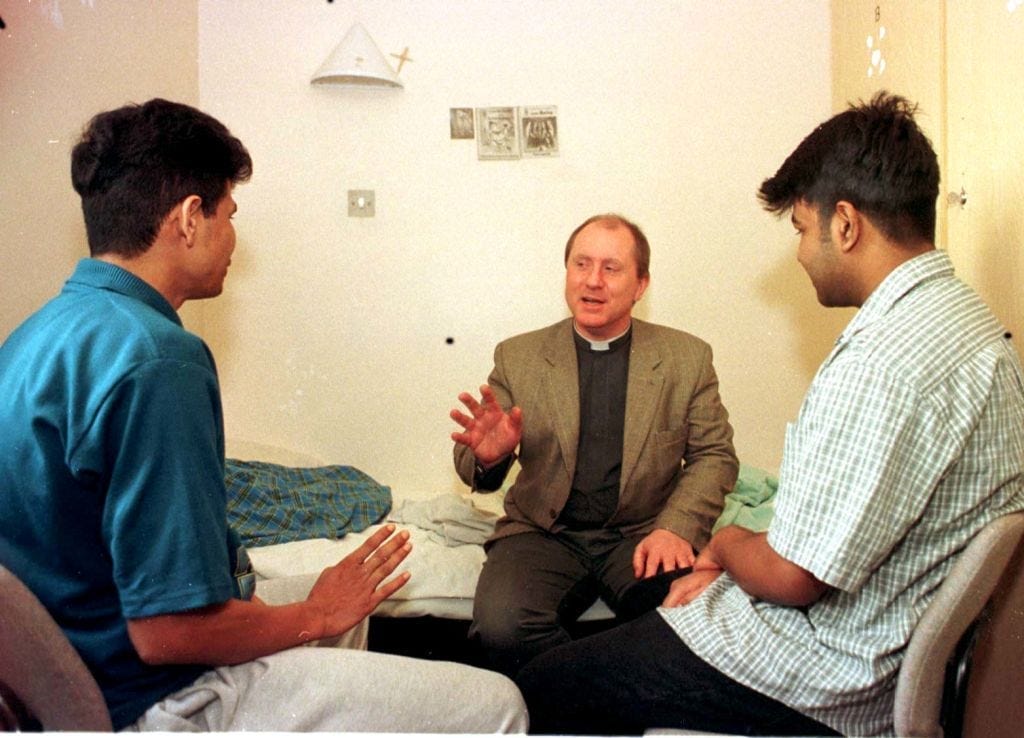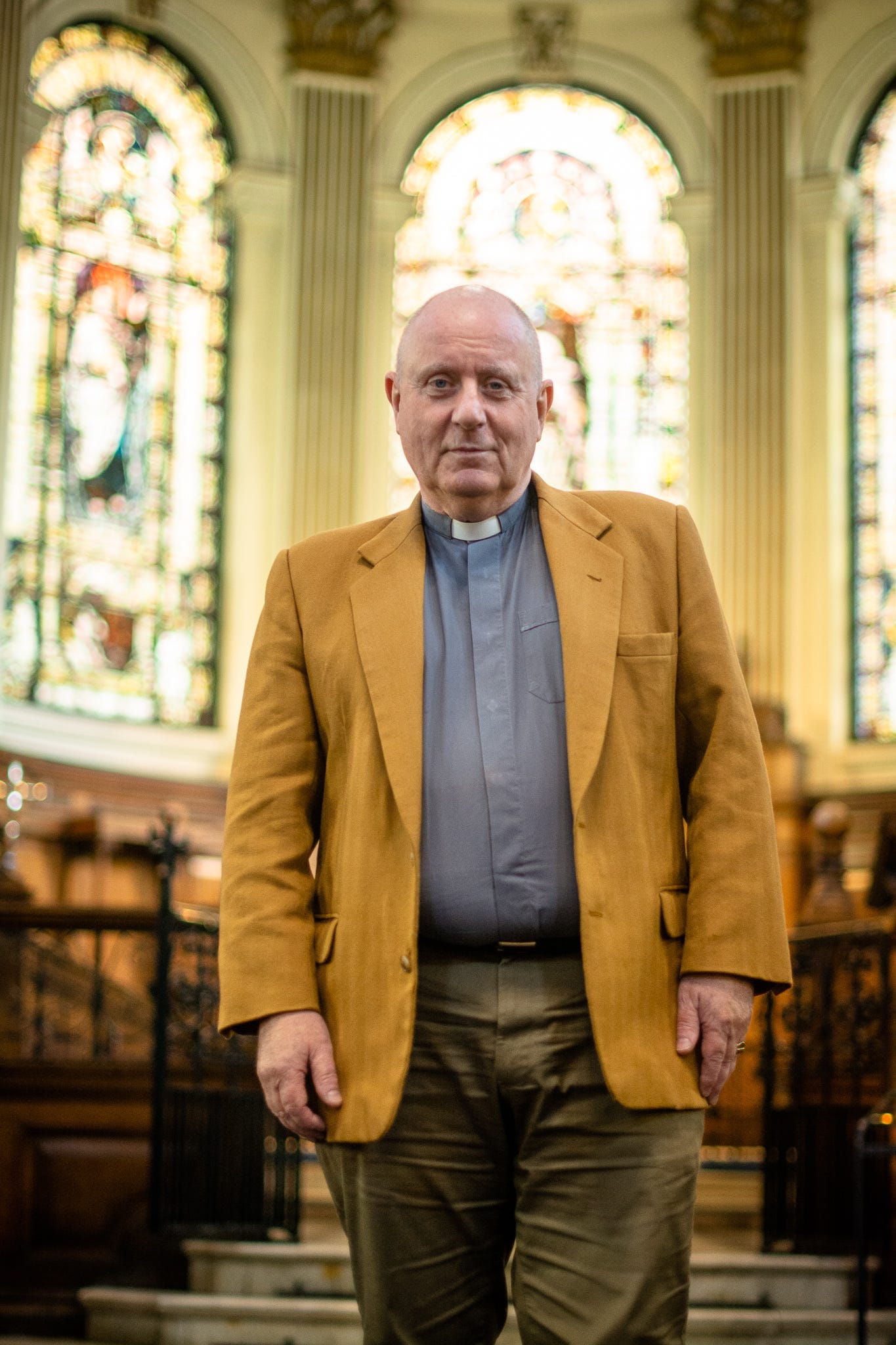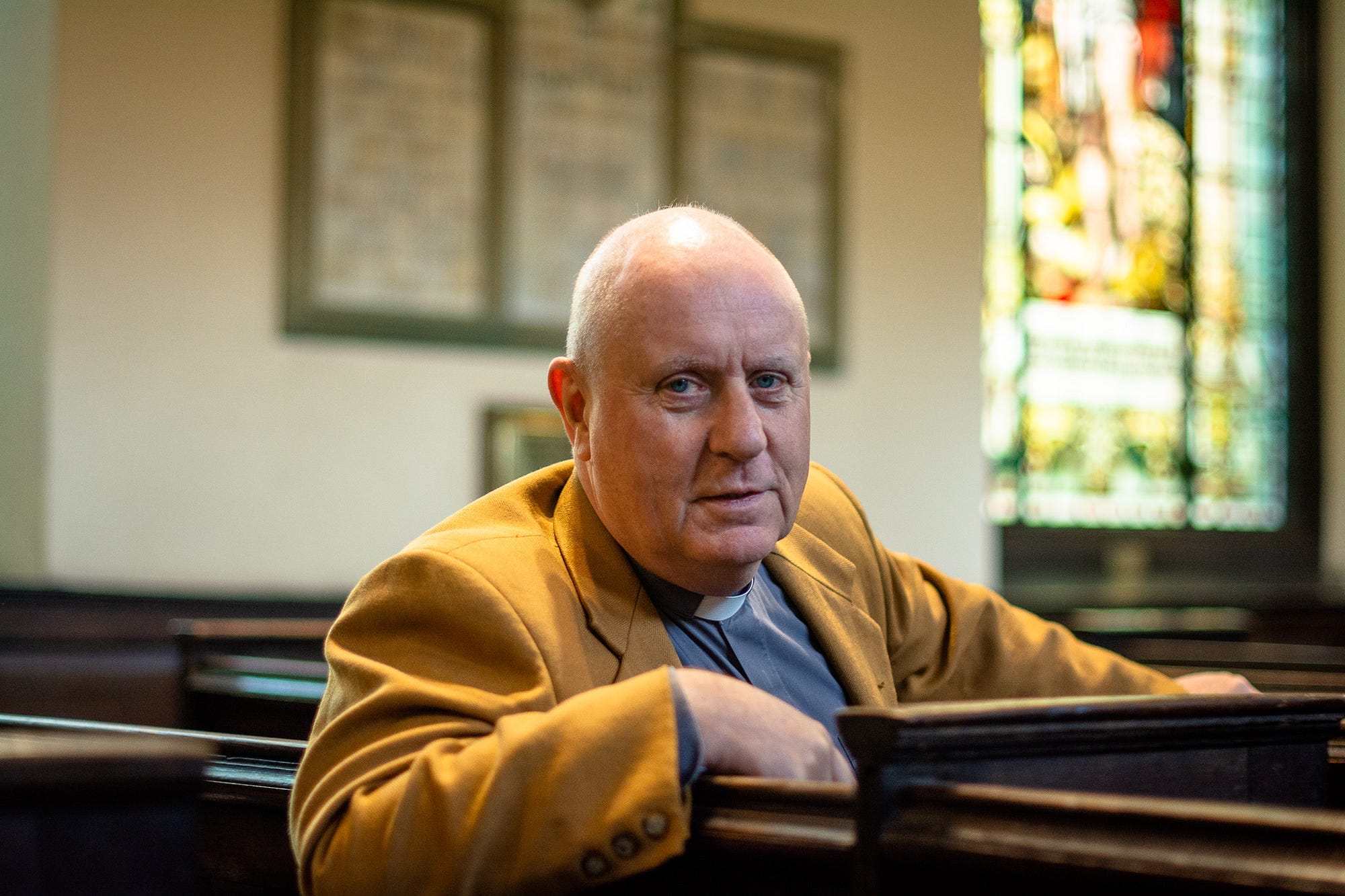By Dani Cole
When he was a boy, Reverend Nigel Ashworth would sometimes visit his father’s office in the Ram Mill, a cotton mill in Chadderton. The workers went about their business on the timber floors in bare feet, because the oil that seeped from the drifts of cotton stained the leather of their shoes.
The clamour from the machinery meant that nobody spoke. Instead, they mouthed their words. “Everyone knew how to lipread,” he says. He remembers the names of other mills too, each name majestic and imposing: Orb Mill, Athens Mill, Rome Mill.
Sometimes business called his father Gordon to Ram Mill, but his principal job was as a trader on the floor of the Royal Exchange on St Ann’s Square. It was the largest trading floor in the world and the lifeblood of the city, but by the time the reverend was a boy in the mid-1960s it was winding down. Those who worked in the industry had their own parlance; traders were known as salesmen, and working on the floor was “being on change”. Contracts were noted in small pocketbooks and at the end of the day, accounts were filed in offices in the upper floors, one of which now serves as The Mill’s newsroom.
Everyone wore white cotton shirts with detachable collars — even now, the reverend only wears cotton shirts out of loyalty to his family, who across the generations were in one way or another tied to the industry. It was customary to wear a suit and tie and don a bowler hat. When he was five, he got into some “fearful trouble” after accidentally sitting on his father’s bowler hat in the back of his car, its top sunken like a deflated sponge cake. I didn’t do it any good at all!” he laughs.

The reverend, 66, was born in Oldham and grew up in Uppermill, Saddleworth. Back then his part of the world belonged to the West Riding of Yorkshire (to many locals it still does). He knew he was a Christian when he was a child. His family wasn’t religious but at the suggestion of his grandmother Louise, he joined his church choir. “It gives you a depth in your life, even though you don’t realise it at the time,” he says. “At that age, your life’s being shaped.” He’s a natural orator with a wry sense of humour, who graciously receives the news that I’m an atheist. He’s also something of an amateur scholar who loves finding out the history of his city and his church — our conversations are gently punctuated by meanders into the past. When The Mill arrived into the neighbourhood, he was one of the first to welcome our fledging paper into the once-bustling newspaper district.
His first job out of university was as a labourer, before he moved into the mental health sector. He was ordained in 1993, and before becoming the rector at St Ann’s in 2008 he was a chaplain at Campsfield House Immigration Detention Centre in Oxford. It housed about 100 people from 29 countries and was one of the biggest in England. He was responsible for detainees’ welfare and ensuring they were able to practice their faiths. Some men arrived into the centre exhausted, dazed and damaged with nothing but plastic bags that contained their life’s possessions. Conditions were poor and they had limited contact with the outside world.
The centre had its share of riots and hunger strikes. He experienced these firsthand. “It’s like a chemical reaction,” he says. After one riot in 1997, religious services were prohibited, but he was having none of it. Despite concerns he would be taken hostage by the men who had only days before been rioting, he held a service for them.

As he preached, some of the congregants cried. For those who couldn’t receive communion, he dabbed their hands with oil. “I anoint you for healing and restoration,” he told them. “Turn away from sin. Do the works of God.” To touch a person’s hands is deeply compassionate and intimate, and that experience is precious to him. “They were very broken people,” he remembers. “They were being treated really horribly by our country and I felt they needed some love and some prayer.”
Ashworth is an enthusiastic proponent proponent of the city centre. His church, which once stood in a cornfield and was consecrated in 1712, has seen Manchester rise around it. When his father took him into town, they would go to Kardomah Cafe on St Ann’s Square, Kendals on Deansgate and his father also showed him St Ann’s Church. Though his father wasn’t religious, he was proud of the industry he worked in, and the church stood in a place that reflected its value. “He would have been so thrilled about me being the rector,” the reverend says. “It’s something I really regret — him not being able to see me become the rector.”
Snowy St Ann's ❄️❄️❄️
— The Mill (@ManchesterMill) 12:29 PM ∙ Nov 28, 2021
In the 1990s, his parish had less than 200 people living in it. Now, it has over 20,000, many of whom are in their 20s and 30s. Getting them into St Ann’s is the next challenge. “They haven’t got a clue what church is,” he laughs. “They’re not easily attracted to church.” Have young people become disillusioned with faith? “Absolute nonsense,” he counters, before explaining that in his experience, they’re turned off by organised expressions of faith — it needs to be organic. “The heart of a human being is a space meant to be filled with God.”
He notes that St Ann’s is a diverse congregation, something which reflects the spirit of the city: Manchester has always accepted new communities, it was built on immigration. “If you’re gay, a gay couple, trans, or black, you can come to St Ann’s,” he says. “That’s incredibly important — you’ve got to look at the type of city this is.”
This spirit of unity was most prominent in the aftermath of the Manchester Arena bombing, and St Ann’s became a focal point for people who wanted to pay their respects. On the Tuesday morning after the bombing, he was in early, waking up at 6am. The city centre was cordoned off, and Manchester was slowly coming to terms with the atrocity.

“I was in shock, immense shock,” he says. He got on the phone to Manchester Cathedral, which was inside the cordoned zone, trying to work out whether they could move some of their services into St Ann’s. A man holding a bunch of yellow flowers was escorted inside by a police officer: could he leave them here? “Oh yes,” he remembers saying. “Just put them here near the font.”
Later he went outside and flowers, cards, toys and bouquets were lined along the edge of the church. More and more flowers arrived until there was a sea of them and they were moved into the square so as not to block the road. “It took on a life of its own,” he says. Thousands of people filed into the church to light candles and sign a book of condolence — 22 books were filled. Then, at the vigil in Albert Square, he said that the solidarity that took place was “the most remarkable school of citizenship.” People of all faiths and none at all came together. “We all experienced something extraordinary,” he says. “It [the vigil] was about our city.” A strong message was sent: “We will not have it trashed.”

Keeping a church running isn’t cheap, and nobody knows this better than the reverend. People who come inside often take photographs of the beautiful stained glass windows — when I go and visit, a trio of women pause to take a selfie with one — and don’t usually notice the cracks in the ceiling. St Ann’s was put on Historic England’s Heritage At Risk Register after inspections deemed that the building was slowly decaying — the sandstone used to build it is soft, which means it’s susceptible to weathering.
Stonemasons came and fixed the roof, but further work is still needed. Since the start of the pandemic, the church has lost £130,000 — it usually costs £150,000 a year to keep the building ticking over, and the money is raised through grants and public donations. The budget for next year is showing a deficit of £30,000 — if they manage to pay all their bills. If they don’t, that figure could be higher.
“It’s not possible,” he says. “We just can’t keep going on with these deficits.” So far St Ann’s has raised £10,000 for its Covid-19 Recovery Fund. Realistically it needs to raise another £100,000. “We really are facing some difficulties,” he says. Is the financial situation stressful for him? He’s not a worrier — more of a strategic, optimistic type of person. He points to Philippians 4:6: “Have no anxiety about anything, but in everything by prayer and supplication with thanksgiving let your requests be made known to God.”
🎄 You are warmly invited to our Christmas fundraising concert at St Ann’s on Thursday 16th December at 7.30pm. Money raised will go towards the church’s Covid-19 Recovery Fund and The Mill. Book your tickets here.
Planning meeting with the Rev Canon Nigel Ashworth at @StAnnsChurchMcr ahead of our 🎄 concert. Get your tickets now 🎟️
— The Mill (@ManchesterMill) 6:00 PM ∙ Dec 2, 2021

Comments
How to comment:
If you are already a member,
click here to sign in
and leave a comment.
If you aren't a member,
sign up here
to be able to leave a comment.
To add your photo, click here to create a profile on Gravatar.






